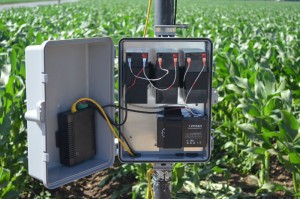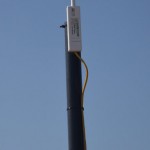 We have been asked multiple times how to extend the AyrMesh network beyond the availability of plug-in power. The key, of course, is solar panels and/or wind turbines, along with batteries
We have been asked multiple times how to extend the AyrMesh network beyond the availability of plug-in power. The key, of course, is solar panels and/or wind turbines, along with batteries to hold the power when the sun isn’t shining or the wind isn’t blowing.
to hold the power when the sun isn’t shining or the wind isn’t blowing.
Tycon Power has solved this problem for us by developing an integrated system just for the AyrMesh products: Hub, Receiver, or Bridge radio. The product to use is their RPPL-1212-36-30 unit. You can buy it directly from Tycon at their store site. This system with the 30 Watt solar panel will work in most of the country that receives an average of 3.5 hours per day or more – the red and dark orange bands on the standard insolation map. For areas in the light orange or yellow areas on that map, you will need to add a second 30W solar panel (with mounting bracket) or a wind turbine to keep the batteries charged.
Tycon also makes larger systems for multiple devices. The RPST-1212-100-70 system will provide power for two or three devices – for instance, a Bridge radio and a Hub or two “back to back” bridge radios.
As with the smaller system, if you get less than an average of 3.5 hours of sunlight per day, you’ll need to augment the power generation of that system with an extra 70W solar panel (and mounting bracket) or the wind turbine.

Higher is better
What does it take to set this up? Two things: very rudimentary wiring skills to connect the batteries and the solar panel with the solar controller, and the ability to set up a strong mast or tower. In our tests, we used a 7′ tall free-standing pole, but, for practical use, you’ll want a much taller pole or tower, embedded into the soil with concrete. You need, of course, to get the radios up as high as practical, but at least 25 feet above any obstacles for maximum range. This may require the use of a pole with guy lines or even a tower.
 The system provides Power over Ethernet (PoE) for the radios, just like the power supplies that come with the AyrMesh products. The mechanical considerations (attaching the solar panel and battery pack to the pole or tower) is extremely simple, using either U-bolts or hose clamps. Using this to extend your network out into your fields will enable you to use the AyrMesh Cab Hub to automatically move data off your in-cab computers and have WiFi coverage in your cab wherever you are on the farm.
The system provides Power over Ethernet (PoE) for the radios, just like the power supplies that come with the AyrMesh products. The mechanical considerations (attaching the solar panel and battery pack to the pole or tower) is extremely simple, using either U-bolts or hose clamps. Using this to extend your network out into your fields will enable you to use the AyrMesh Cab Hub to automatically move data off your in-cab computers and have WiFi coverage in your cab wherever you are on the farm.
If you have any questions about this, of course, please feel free to comment on this post or get in touch with us at [email protected].
